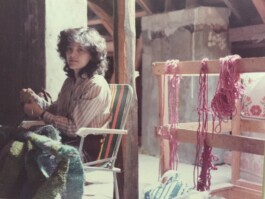From the beginning, my life has been woven with threads - pulled through sewing machines, knotted into textiles, dyed in kitchen pots. But also with paint smears from my father's studio, clay under my fingernails, and the earthy scent of my grandmother's garden. Craftsmanship isn't just what I do; it's the language my family spoke through their hands.
In Colombia, my grandmothers Yuyis and Luzmaria stitched their love into existence. Yuyis' sewing machine hummed in a tiny garden-facing room where she first guided my child hands. Luzmaria's dresses - some sixty years old - still hang in my closet. Their generation made clothing as both necessity and art, a duality that shaped me.
My mother transformed this legacy into textile design. I observed her warp fique fibers on a DIY loom in Hamburg, creating tapestries that carried Colombia across oceans. My father painted campesinos' working hands, their strength echoing in our weekend trips through Cundinamarca's artisan markets. Our home vibrated with creation.
I absorbed making through every pore. Kneading clay), stitching doll clothes that evolved into teenage upcycled fashions, digging fingers into soil like my carpenter great-grandfather once dug into wood. These weren't hobbies but a continuous thread: Yuyis fixing household systems with the same hands that knitted sweaters, my mother dyeing threads while seven months pregnant, my father teaching art with me at his elbow.
Now when I work, I don't reminisce. I continue. In a disposable world, these handmarks matter - not as nostalgia, but as living practice. Every stitch still says what my grandmothers taught me: creation is the most honest kind of care.

Juanita, my mother, in Hamburg 1984
From the beginning, my life has been woven with threads - pulled through sewing machines, knotted into textiles, dyed in kitchen pots. But also with paint smears from my father's studio, clay under my fingernails, and the earthy scent of my grandmother's garden. Craftsmanship isn't just what I do; it's the language my family spoke through their hands.
In Colombia, my grandmothers Yuyis and Luzmaria stitched their love into existence. Yuyis' sewing machine hummed in a tiny garden-facing room where she first guided my child hands. Luzmaria's dresses - some sixty years old - still hang in my closet. Their generation made clothing as both necessity and art, a duality that shaped me.
My mother transformed this legacy into textile design. I observed her warp fique fibers on a DIY loom in Hamburg, creating tapestries that carried Colombia across oceans. My father painted campesinos' working hands, their strength echoing in our weekend trips through Cundinamarca's artisan markets. Our home vibrated with creation.
I absorbed making through every pore. Kneading clay), stitching doll clothes that evolved into teenage upcycled fashions, digging fingers into soil like my carpenter great-grandfather once dug into wood. These weren't hobbies but a continuous thread: Yuyis fixing household systems with the same hands that knitted sweaters, my mother dyeing threads while seven months pregnant, my father teaching art with me at his elbow.
Now when I work, I don't reminisce. I continue. In a disposable world, these handmarks matter - not as nostalgia, but as living practice. Every stitch still says what my grandmothers taught me: creation is the most honest kind of care.

Juanita, my mother, in Hamburg 1984